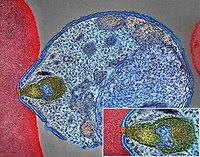
Photo from wikipedia
South Africa’s malaria elimination plans are aligned to the World Health Organization’s aim for a malaria-free world and include specific objectives within a specified time frame. These are proving difficult… Click to show full abstract
South Africa’s malaria elimination plans are aligned to the World Health Organization’s aim for a malaria-free world and include specific objectives within a specified time frame. These are proving difficult to achieve owing to the sporadic nature of locally acquired malaria in some affected districts, while other districts that were endemic for the disease are either malaria-free or very close to that goal. The WHO also specifies that continued measures to prevent the re-establishment of transmission are required in areas where elimination has been achieved. These measures include routine malaria vector surveillance in endemic districts that are free of malaria to assess receptivity and risk of reintroduction, which may prove difficult to justify in the face of competing public health priorities and limited resources. These issues are discussed here within the framework of vector surveillance and control and include recommendations on how they can be addressed going forward.
Journal Title: Tropical Medicine and Infectious Disease
Year Published: 2022
Link to full text (if available)
Share on Social Media: Sign Up to like & get
recommendations!